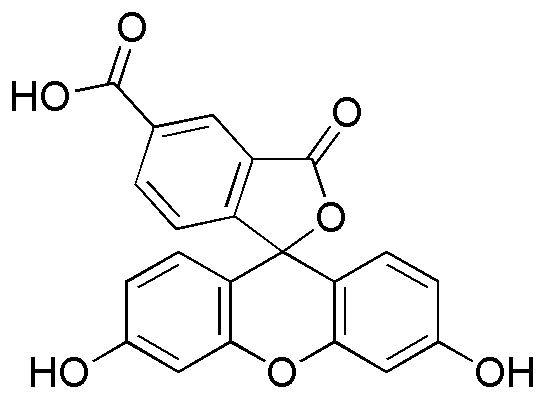5-Carboxyfluorescein is widely utilized in research focused on:
- Fluorescent Probes: This compound serves as an effective fluorescent marker in biological assays, allowing researchers to visualize cellular processes and track biomolecules in real-time.
- pH Indicators: Due to its pH-sensitive fluorescence, it is used in various applications to measure acidity levels in solutions, making it valuable in environmental monitoring and food safety testing.
- Drug Delivery Systems: Its properties enable it to be incorporated into drug formulations, enhancing the tracking of drug release and distribution within biological systems, which is crucial in pharmaceutical research.
- Immunoassays: The compound is commonly employed in enzyme-linked immunosorbent assays (ELISAs) for the detection of specific proteins, aiding in clinical diagnostics and research.
- Bioconjugation: It is often used to label antibodies and other biomolecules, facilitating studies in proteomics and molecular biology by improving the detection and analysis of target molecules.
General Information
Properties
Safety and Regulations
Applications
5-Carboxyfluorescein is widely utilized in research focused on:
- Fluorescent Probes: This compound serves as an effective fluorescent marker in biological assays, allowing researchers to visualize cellular processes and track biomolecules in real-time.
- pH Indicators: Due to its pH-sensitive fluorescence, it is used in various applications to measure acidity levels in solutions, making it valuable in environmental monitoring and food safety testing.
- Drug Delivery Systems: Its properties enable it to be incorporated into drug formulations, enhancing the tracking of drug release and distribution within biological systems, which is crucial in pharmaceutical research.
- Immunoassays: The compound is commonly employed in enzyme-linked immunosorbent assays (ELISAs) for the detection of specific proteins, aiding in clinical diagnostics and research.
- Bioconjugation: It is often used to label antibodies and other biomolecules, facilitating studies in proteomics and molecular biology by improving the detection and analysis of target molecules.
Documents
Safety Data Sheets (SDS)
The SDS provides comprehensive safety information on handling, storage, and disposal of the product.
Product Specification (PS)
The PS provides a comprehensive breakdown of the product’s properties, including chemical composition, physical state, purity, and storage requirements. It also details acceptable quality ranges and the product's intended applications.
Certificates of Analysis (COA)
Search for Certificates of Analysis (COA) by entering the products Lot Number. Lot and Batch Numbers can be found on a product’s label following the words ‘Lot’ or ‘Batch’.
Número de catálogo
Número de lote/lote
Certificates Of Origin (COO)
This COO confirms the country where the product was manufactured, and also details the materials and components used in it and whether it is derived from natural, synthetic, or other specific sources. This certificate may be required for customs, trade, and regulatory compliance.
Número de catálogo
Número de lote/lote
Safety Data Sheets (SDS)
The SDS provides comprehensive safety information on handling, storage, and disposal of the product.
DownloadProduct Specification (PS)
The PS provides a comprehensive breakdown of the product’s properties, including chemical composition, physical state, purity, and storage requirements. It also details acceptable quality ranges and the product's intended applications.
DownloadCertificates of Analysis (COA)
Search for Certificates of Analysis (COA) by entering the products Lot Number. Lot and Batch Numbers can be found on a product’s label following the words ‘Lot’ or ‘Batch’.
Número de catálogo
Número de lote/lote
Certificates Of Origin (COO)
This COO confirms the country where the product was manufactured, and also details the materials and components used in it and whether it is derived from natural, synthetic, or other specific sources. This certificate may be required for customs, trade, and regulatory compliance.


